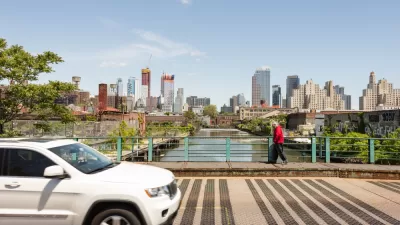A controversial zoning—one of the last of a de Blasio administration that has rezoned parts of every borough in the city—last week cleared a key City Council committee.

"Mayor Bill de Blasio’s controversial plan to rezone Gowanus is poised to move forward, fulfilling a decade-old ambition that aims to increase development and affordability in the fast-changing industrial enclave," reports Jake Offenhartz.
The City Council Land Use Committee voted to approve the rezoning on November 10, paving the way for up to 8,000 new apartments units, with one-third of those units reserved for low-income tenants, in the relatively wealthy corner of New York City.
The city's planning commission approved the Gowanus Neighborhood Planning Study in September, paving the way for last week's City Council’s Land Use Committee vote. The Gowanus rezoning plan previously encountered Covid-related delays and repeated bouts of controversy.
Offenhartz describe the rezoning as the largest upzoning of the de Blasio era—and there are plenty of other examples to compare, though the recent rezoning processes in Gowanus, along with the Envision NoHo/SoHo rezoning in Manhattan, are the first to focus on more affluent corners of the city (more on the same subject is found here and here). Earlier in its tenure, the de Blasio administration undertook rezonings in East New York, Downtown Far Rockaway, East Harlem, Jerome Avenue, Inwood, the Bay Street Corridor on Staten Island, Bushwick, and a swath of Southern Boulevard in the Bronx.
In 2014, the de Blasio administration announced the Housing New York plan to spend $41 billion to create or preserve 200,000 affordable housing units in the city, which included a Mandatory Inclusionary Housing program that influenced all of these rezoning programs.
FULL STORY: Agreement On Gowanus Rezoning Will Bring 8,000 New Apartments, Public Housing Investment

Alabama: Trump Terminates Settlements for Black Communities Harmed By Raw Sewage
Trump deemed the landmark civil rights agreement “illegal DEI and environmental justice policy.”

Planetizen Federal Action Tracker
A weekly monitor of how Trump’s orders and actions are impacting planners and planning in America.

Why Should We Subsidize Public Transportation?
Many public transit agencies face financial stress due to rising costs, declining fare revenue, and declining subsidies. Transit advocates must provide a strong business case for increasing public transit funding.

Understanding Road Diets
An explainer from Momentum highlights the advantages of reducing vehicle lanes in favor of more bike, transit, and pedestrian infrastructure.

New California Law Regulates Warehouse Pollution
A new law tightens building and emissions regulations for large distribution warehouses to mitigate air pollution and traffic in surrounding communities.

Phoenix Announces Opening Date for Light Rail Extension
The South Central extension will connect South Phoenix to downtown and other major hubs starting on June 7.
Urban Design for Planners 1: Software Tools
This six-course series explores essential urban design concepts using open source software and equips planners with the tools they need to participate fully in the urban design process.
Planning for Universal Design
Learn the tools for implementing Universal Design in planning regulations.
Caltrans
Smith Gee Studio
Institute for Housing and Urban Development Studies (IHS)
City of Grandview
Harvard GSD Executive Education
Toledo-Lucas County Plan Commissions
Salt Lake City
NYU Wagner Graduate School of Public Service



























